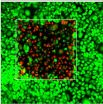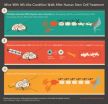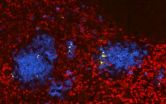(Press-News.org) BUFFALO, N.Y. – Photodynamic therapy (PDT) is an effective treatment for easily accessible tumors such as oral and skin cancer.
But the procedure, which uses lasers to activate special drugs called photosensitizing agents, isn't adept at fighting cancer deep inside the body. Thankfully, that's changing due to new technology that could bring PDT into areas of the body which were previously inaccessible.
Described May 11 in the journal Nature Photonics, the approach involves using near-infrared beams of light that, upon penetrating deep into the body, are converted into visible light that activates the drug and destroys the tumor.
"We expect this will vastly expand the applications for an effective cancer phototherapy that's already in use," said co-author Tymish Ohulchanskyy, PhD, University at Buffalo research associate professor and deputy director for photomedicine at the university's Institute for Lasers, Photonics and Biophotonics (ILPB).
Doctors have used PDT to treat cancer for decades. Cancer cells absorb the drug, which is delivered to the tumor via the bloodstream or locally. Visible light is then applied to the site, which causes the drug to react with oxygen and create a burst of free radicals that kill the tumor.
Unfortunately, visible light does not penetrate tissue well. Conversely, near-infrared light penetrates tissue well but doesn't activate the drugs efficiently.
To solve this problem, some researchers are developing drugs that absorb near-infrared light. This method is limited, however, because stable and efficient near-infrared absorbing photosenzitizers are notoriously difficult to synthesize.
The UB-led team took a different approach, which uses the tumor's natural environment to tune the light into the necessary wavelengths.
For example, the near-infrared laser beam interacts with the natural protein collagen, which is found in connective tissues. The interaction changes the near-infrared light to visible light, a process known as second harmonic generation. Likewise, natural proteins and lipids within the cells interact with near-infrared laser light and change it to visible light through another process called four-wave mixing.
Thus, visible light can be generated in tumors deep inside the body, and it can be absorbed by the drug. This activates the drug, which then destroys the tumor.
The procedure has numerous advantages, said the study's leader, Paras Prasad, PhD, SUNY Distinguished Professor in chemistry, physics, electrical engineering, and medicine at UB, and the ILPB's executive director.
"There are no long-term side effects for PDT, it's less invasive than surgery, and we can very precisely target cancer cells," he said. "With our approach, PDT is enriched to provide another tool that doctors can use to alleviate the pain of millions of people suffering from cancer."
UB has applied for a patent to protect the team's discovery, and the university's Office of Science, Technology Transfer and Economic Outreach (UB STOR) is discussing potential license agreements with companies interested in commercializing it.
The research is a collaboration between ILPB, Shenzhen University in China and Korea University in Korea, with which Prasad is affiliated. It was supported in part by a grant from the U.S. Air Force of Scientific Research. Other co-authors are Aliaksandr Kachynski, Artem Pliss, Andrey Kuzmin and Alexander Baev, all PhDs and researchers within ILPB, and Junle Qu, PhD, Shenzhen University.
INFORMATION:
Going beyond the surface
New tech could take light-based cancer treatment deep inside the body
2014-05-15
ELSE PRESS RELEASES FROM THIS DATE:
How octopuses don't tie themselves in knots
2014-05-15
VIDEO:
An octopus is treating its own freshly amputated arm in a strange and exploratory manner that is not commonly seen with respect to food items. Note the 'startle' response of...
Click here for more information.
An octopus's arms are covered in hundreds of suckers that will stick to just about anything, with one important exception. Those suckers generally won't grab onto the octopus itself; otherwise, the impressively flexible animals would quickly find themselves all tangled ...
First test of pluripotent stem cell therapy in monkeys is a success
2014-05-15
Researchers have shown for the first time in an animal that is more closely related to humans that it is possible to make new bone from stem-cell-like induced pluripotent stem cells (iPSCs) made from an individual animal's own skin cells. The study in monkeys reported in the Cell Press journal Cell Reports on May 15th also shows that there is some risk that those iPSCs could seed tumors, but that unfortunate outcome appears to be less likely than studies in immune-compromised mice would suggest.
"We have been able to design an animal model for testing of pluripotent ...
Mice with MS-like condition walk again after human stem cell treatment
2014-05-15
(SALT LAKE CITY) - Mice severely disabled by a condition similar to multiple sclerosis (MS) were able to walk less than two weeks following treatment with human neural stem cells. The finding, which uncovers potential new avenues for treating MS, will be published online on May 15, 2014, in the journal Stem Cell Reports.
In striking contrast to active, healthy mice, those with an MS-like condition must be fed by hand because they cannot stand long enough to eat and drink on their own. When scientists transplanted human neural stem cells into the MS mice, they expected ...
Not just a pretty face, although that helps female politicians on election day
2014-05-15
Female politicians' success can be predicted by their facial features, especially in conservative states where women with more feminine faces tend to do better at the ballot box, a Dartmouth College-led study finds.
The results don't mean a supermodel will win the White House, but they do suggest women's electoral success requires a delicate balance between voters' perception of traditional femininity and political competence. The study appears in the journal Social Psychological and Personality Science. A PDF of the study is available on request. Here is a video animation ...
Stem cell therapy shows promise for MS in mouse model
2014-05-15
LA JOLLA, CA—May 15, 2014—Mice crippled by an autoimmune disease similar to multiple sclerosis (MS) regained the ability to walk and run after a team of researchers led by scientists at The Scripps Research Institute (TSRI), University of Utah and University of California (UC), Irvine implanted human stem cells into their injured spinal cords.
Remarkably, the mice recovered even after their bodies rejected the human stem cells. "When we implanted the human cells into mice that were paralyzed, they got up and started walking a couple of weeks later, and they completely ...
Genetic tracking identifies cancer stem cells in human patients
2014-05-15
The gene mutations driving cancer have been tracked for the first time in patients back to a distinct set of cells at the root of cancer – cancer stem cells.
The international research team, led by scientists at the University of Oxford and the Karolinska Institutet in Sweden, studied a group of patients with myelodysplastic syndromes – a malignant blood condition which frequently develops into acute myeloid leukaemia.
The researchers say their findings, reported in the journal Cancer Cell, offer conclusive evidence for the existence of cancer stem cells.
The concept ...
Combination therapy a potential strategy for treating Niemann Pick disease
2014-05-15
CAMBRIDGE, Mass. (May 15, 2014) – By studying nerve and liver cells grown from patient-derived induced pluripotent stem cells (iPSCs), Whitehead Institute researchers have identified a potential dual-pronged approach to treating Niemann-Pick type C (NPC) disease, a rare but devastating genetic disorder.
According to the National Institutes of Health (NIH), approximately 1 in 150,000 children born are afflicted with NPC, the most common variant of Niemann-Pick. Children with NPC experience abnormal accumulation of cholesterol in their liver and nerve cells, leading to ...
'Bystander' chronic infections thwart development of immune cell memory
2014-05-15
PHILADELPHIA – Studies of vaccine programs in the developing world have revealed that individuals with chronic infections such as malaria and hepatitis tend to be less likely to develop the fullest possible immunity benefits from vaccines for unrelated illnesses. The underlying mechanisms for that impairment, however, are unclear, and distinguishing these so-called "bystander" effects on priming the immune system to fight future assaults versus development of immunological memory has been challenging.
A team from the Perelman School of Medicine at the University of Pennsylvania ...
E-cigarette awareness goes up, as (apparently) so does skepticism
2014-05-15
PHILADELPHIA (May 15, 2014) – Americans are unquestionably more aware of e-cigarettes, those vapor-emitting alternatives to tobacco cigarettes, according to a national survey. Yet, at the same time, the belief that e-cigarettes are safer than traditional smokes may be starting to diminish.
A national survey of 3,630 adults found that 77 percent of the respondents have heard of e-cigarettes; that's way up from 16 percent just five years ago. But the perception that e-cigarettes are actually less harmful than tobacco cigarettes among current smokers decreased slightly, ...
Protein sharpens salmonella needle for attack
2014-05-15
A tiny nanoscale syringe is Salmonella's weapon. Using this, the pathogen injects its molecular agents into the host cells and manipulates them to its own advantage. A team of scientists at the Biozentrum of the University of Basel demonstrate in their current publication in Cell Reports that a much investigated protein, which plays a role in Salmonella metabolism, is required to activate these needles and makes the replication and spread of Salmonella throughout the whole body possible.
The summer months are the prime time for Salmonella infections. Such an infection ...
LAST 30 PRESS RELEASES:
Making simulations more accurate than ever with deep learning
Better predicting the lifespan of clean energy equipment, towards a more efficient design
Five ways microplastics may harm your brain
Antibody halts triple-negative breast cancer in preclinical models
Planned birth at term reduces pre-eclampsia in those at high risk
Penguins starved to death en masse, study warns, as some populations off South Africa estimated to have fallen 95% in just eight years
New research explains how our brains store and change memories
Space shuttle lessons: Backtracks can create breakthroughs
New study finds cystic fibrosis drug allows patients to safely scale back lung therapies
From field to lab: Rice study reveals how people with vision loss judge approaching vehicles
Study highlights underrecognized link between kidney disease and cognitive decline
Researchers find link between psychosocial stress and early signs of heart inflammation in women
Research spotlight: How long-acting injectable treatment could transform care for postpartum women with HIV
Preempting a flesh-eating fly’s return to California
Software platform helps users find the best hearing protection
Clean hydrogen breakthrough: Chemical lopping technology with Dr. Muhammad Aziz (full webinar)
Understanding emerges: MBL scientists visualize the creation of condensates
Discovery could give investigators a new tool in death investigations
Ultrasonic pest control to protect beehives
PFAS mixture disrupts normal placental development which is important for a healthy pregnancy
How sound moves on Mars
Increasing plant diversity in agricultural grasslands boosts yields, reducing reliance on fertilizer
Scientists uncover a new role for DNA loops in repairing genetic damage
AI chatbots can effectively sway voters – in either direction
Study reveals 'levers' driving the political persuasiveness of AI chatbots
'Tiny' tyrannosaurid, Nanotyrannus lancensis, was a distinctive species, not juvenile T. Rex
Scientists capture first detailed look inside droplet-like structures of compacted DNA
Return of the short (tyrant) king: A new paper by Dinosaur Institute researcher shows Nanotyrannus was not a juvenile T. Rex
New study confirms Nanotyrannus holotype was distinct species from T. rex
Carnegie Science names Michael Blanton 12th Observatories Director
[Press-News.org] Going beyond the surfaceNew tech could take light-based cancer treatment deep inside the body




